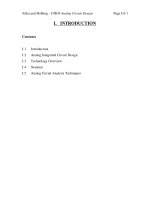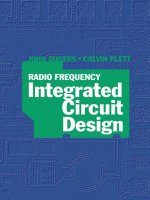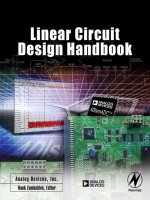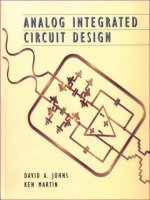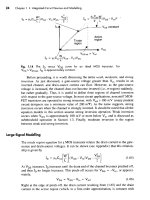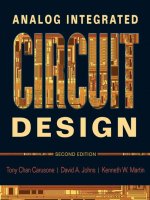Analog circuit design
Bạn đang xem bản rút gọn của tài liệu. Xem và tải ngay bản đầy đủ của tài liệu tại đây (22.33 MB, 410 trang )
SERIES
FOR
DESIGN ENGINEER!
1'1
ircuit
I
I
I
Hrt,
Science, and Pe
Analog
Circuit
Design
Analog
Circuit
Design
Art,
Science,
and
Personalities
Edited
by
Jim
Williams
Butterworth-Heinemann
Boston
London
Oxford
Singapore
Sydney Toronto
Wellington
Buttenvorth Heinemann is an imprint
of
Elsevier Science.
Copyright 1991 by Elsevier Science
USA.
All rights reserved.
No
part of this publication may be reproduced, stored in a retrieval system, or transmitted in
any form
or
by any means, electronic, mechanical, photocopying, recording, or otherwise,
without the prior written permission of the publisher.
$3
This book is printed on acid-free paper.
Library
of
Congress Cataloging-in-Publication Data
Analog circuit design: art, science, and personalities
/
edited by
Jim Williams.
p.
Includes bibliographical references and index.
1.
cm.
-
(The EDN series for design engineers)
ISBN 0-7506-9 166-2
Linear integrated circuits-Maintenance and repair.
2. Electronic circuit design. I. Williams, Jim, 1948
11. Series
TK7874.A548 1991
621,381’5-dc20
9 1-9930
CIP
British Library Cataloguing-in-Publication Data
1.
Analogue circuits, Design
I. Williams, Jim 1948- 11. Series
621.3815
ISBN 0-7506-9640-0
The publisher offers special discounts on bulk orders
of
this book.
For information, please contact:
Manager of Special Sales
Elsevier Science
200 Wheeler Road
Burlington,
MA
01 803
Fax: 781-313-4802
Tell
781-313-4700
10
Printed
in
the
United States of America
Editorial, design and production services provided
by
HighText Publications, Inc.
Solana Beach, California.
For
Celia, Michael, and Bonillas.
These are
my
friends, and this
is
what we do.
Bob Widlar's contributions, albeit not received
for this book, are acknowledged by
all.
Contents
Preface
xi
Contributors
xiii
One Introduction
1.
Barometers and Analog Design 3
2.
Analogs Yesterday, Today, and Tomorrow,
or
Alexander Calandra
Metaphors
of
the Continuum 5
George A. Philbrick
Dan Sheingold
Jim Williams
3.
It's
An Analog World-Or
Is
it?
15
4.
Is
Analog Circuit Design Dead?
17
5.
On
Being
the
Machine 23
6.
Reflections of a Dinosaur
31
7.
Max Wien, Mr. Hewlett, and a Rainy Sunday Afternoon 43
Bernard Gordon
Samuel Wilensky
Jim Williams
Three The Making
of
an Analog Engineer
8.
True Analog Circuit Design
59
9. The Story
of
the P2 (The First Successful Solid-state Operational
Tom
Hornak
Amplifier With Picoampere Input Currents)
67
Bob
Pease
vii
Contents
10. Propagation of the Race (of Analog Circuit Designers) 79
11. The Process of Analog Design 89
12. Analog Design Discipline: A Tale
of
Three Diodes 93
13. Should Ohm's Law Be Repealed? 99
Jim Roberge
Rod Russell
Milton Wilcox
Jim
Williams
Four Intuitions and Insights
14. Good Engineering and Fast Vertical Amplifiers 107
15.
Understanding Why Things Don't Work 123
16. Building Blocks for the Linear
IC
Designer:
Linear Synthesis for Monolithic Circuits 127
John Addis
Bob Blauschild
A. Paul Brokaw
17.
How
to
Design Analog Circuits Without a Computer
or
a
Lot of Paper 149
18. Starting to Like Electronics in Your Twenties 169
19. Where Do Little Circuits Come From? 177
20. The Process of Analog Design 187
21. The Art of Good Analog Circuit Design-Some Basic Problems
Richard
S.
Burwen
George Erdi
Barrie Gilbert
Garry Gillette
and Possible Solutions 193
Barry Hilton
22.
My
Approach to Feedback Loop Design 199
23. The
Zoo
Circuit: History, Mistakes, and
Some Monkeys Design
a
Circuit 215
Phil Perkins
Jim Williams
viii
Contents
Five Techniques, Tips, and Applications
24. Reality-Driven Analog Integrated Circuit Design 233
25. Current-Feedback Amplifiers 261
26. Analog Extensions
of
Digital Time and
Derek
F.
Bowers
Sergio Franco
Frequency Generation 277
Garry
Gillette
27. Some Practical Aspects
of
SPICE
Modeling for Analog
Circuits 299
E.
J.
Kennedy
Robert
f.
Matthys
28. Design
of
Crystal Oscillator Circuits
333
29. A Tale
of
Voltage-to-Frequency Converters
(Ancient History) 349
Rob
Pease
30.
Op
Amps and Their Characteristics 361
Dan
Sheingold
Index
387
ix
Preface
This is a weird book. When I was asked to write it I refused, because
I
didn’t
believe anybody could, or should,
try
to explain how to do analog design. Later,
I
decided the book might
be
possible, but only if it was written by many authors,
each with their own style, topic, and opinions. There should be an absolute mini-
mum of editing, no subject or style requirements, no planned page count, no
outline, no nothing! I wanted the book’s construction to reflect its subject. What
I
asked for was essentially a mandate for chaos. To my utter astonishment the
publisher agreed and we lurched hopefully forward.
A meeting at my home in February 1989 was well-attended by potential par-
ticipants. What we concluded went something like this: everyone would go off
and write about anything that could remotely be construed as relevant to analog
design. Additionally, no author would tell any other author what they were
writing about. The hope was that the reader would see many different styles and
approaches to analog design, along with some commonalities. Hopefully, this
would lend courage to someone seeking to do analog work. There are many very
different ways to proceed, and every designer has to find a way that feels right.
This evolution of a style, of getting
to
know oneself, is critical
to
doing good
design. The single greatest asset a designer has is self-knowledge. Knowing
when your thinking feels right, and when you’re trying to fool yourself. Recog-
nizing when the design is where you want it to
be,
and when you’re pretending
it
is
because you’re only human. Knowing your strengths and weaknesses,
prowesses and prejudices. Learning to recognize when to ask questions and
when to believe your answers.
Formal training can augment all this, but cannot replace
it
or
obviate its
necessity.
I
think that factor is responsible for some
of
the mystique associated
with analog design. Further,
I
think that someone approaching the field needs
to see that there are lots of ways to do this stuff. They should be made to feel
comfortable experimenting and evolving their own methods.
The risk in this book, that it will come across as an exercise in discord, is also
its promise.
As
it
went together,
I
began to feel less nervous. People wrote about
all kinds of things in all kinds of ways. They had some very different views of
the world. But also detectable were commonalities many found essential. It is
our hope that readers will see this somewhat discordant book as a reflection
of
the analog design process. Take what you like, cook it any way you want to, and
leave the rest.
Things wouldn’t be complete without a special thanks to Carol Lewis and
Harry
Helms at HighText Publications, and John Martindale at Butterworth-
Heineniann Publishers. They took on a book with an amorphous charter and
no
rudder and made it work.
A
midstream change of publishers didn’t bother Carol
and Harry, and John didn’t seem to get nervous over a pretty risky approach to
book writing.
I
hope this book is as interesting and fun to read as it was to put together.
Have a good time.
xi
Contributors
JIM
WILLIAMS
is
the editor-in-chief of this book.
In
this role. Jim developed the
basic concept of the book, identified, contacted, and cajoled potential contributors,
and served as the “guiding light” of the entire project. Jim was at the Massachusetts
Institute of Technology from 1969 to 1979, concentrating exclusively on analog
circuit design. His teaching and research interests involved application of analog
circuit techniques to biochemical and biomedical problems. Concurrently, he con-
sulted U.S. and foreign concerns and governments, specializing in analog circuits.
In 1979, he moved to National Semiconductor Corp., continuing work in the analog
area with the Linear Integrated Circuits Group. In 1983, he joined Linear Technology
Corp. as staff scientist, where he is presently employed. Interests include product
definition, development, and support. Jim has authored over 250 publications relat-
ing to analog circuit design. His spare time interests include sports cars, collecting
antique scientific instruments, art. and restoring and using old Tektronix oscillo-
scopes. He lives
in
Belmont, California, with his wife Celia,
son
Michael, a dog
named Bonillas and 14 Tektronix oscilloscopes.
JOHN
ADDIS
received his B.S.E.E. from the Massachusetts Institute
of
Technology
in 1963 and joined Tektronix that same year. His career at Tektronix has been spent
in the design of various vertical amplifiers and pulse sources. The products John has
engineered include the IA7, 10A2A, 7A1
I,
485 vertical preamplifier, 7A29, and
the analog paths of the 11A32, 11A34, and 11A52.
He
holds 14 U.S. patents, and
was formerly responsible for analog integrated circuit design for high-speed oscillo-
scopes at Tektronix. He is now a consultant on analog design. John has traveied
widely. including three trips to
the
Soviet Union and two to South America.
BOB BLAUSCHILD
received his
B.S.E.E.
from Columbia University in 1971 and
his
M.S.E.E. from the University of California at Berkeley in 1973. He is also proud of
his diploma from Ridgefield Memorial High School
in
New Jersey. Bob is currently
maiiager of advanced analog development for Signetics. and has previously been an
independent design consultant. He holds 12 patents in the area
of
analog circuit
design, served ten years on the program committee for the International Solid State
Circuits Conference, and is the author of numerous technical papers. His hobbies
include running, visiting with old friends, coaching in the Special Olympics. and
daydreaming
of
retirement on a warm beach.
DEREK
F.
BOWERS
was born
in
Maesteg, Wales in 1954 and received
a
B.Sc. in
physics and mathematics from the University of Sheffield in 1976. His first posi-
tions were with the University Space Physics Group and Triad Computing Systems.
In 1978, he joined Precision Monolithics, Inc.’s
U.K.
division. In 1980, he trans-
ferred
to
Santa Clara as a senior design engineer. Since then he has held various
positions within the company and is currently staff vice president, design. He has
over thirty integrated circuit designs in volume production, including
op
amps,
instrumentation amplifiers, audio products, and data conversion circuits. Derek has
authored
35
technical articles and publications and holds ten patents. He is also a
xiii
Contributors
senior member of the IEEE and a member of the Audio Engineering Society.
In
his
spare time, he enjoys music and regards himself as a connoisseur of beer and exor-
bitantly spicy food.
A.
PAUL BROKAW
spent his early years investigating flashlight workings and dis-
emboweling toasters. After obtaining his B.S. in physics from Oklahoma State
University, he developed electronics
for
scientific satellites with Labko Scientific,
Inc. He also worked with Arthur D. Little, Inc., as a circuit design consultant. In
197 1, he joined Nova Devices, which eventually became the semiconductor divi-
sion of Analog Devices. He has held several positions at Analog, generally related
to design, and is now an Analog Fellow. He holds over
50
U.S.
patents in such areas
as analog-to-digital and digital-to-analog converters, references, amplifiers, and
application-specific integrated circuits. He has published technical papers in several
TEEE journals, and is an IEEE Fellow.
RICHARD
S.
BURWEN
received a
S.B.
(cum laude)
in
physics in 1949 and an A.M.
in
engineering sciences and applied physics in 1950 from Harvard. He was one of
the three founders of Analog Devices and worked as a consultant to the company,
designing several of the circuits for its initial product lines. Other companies with
which he was associated in their beginning phases have included Mark Levinson
Audio Systems, Cello Ltd., and Novametrix Medical Systems. He became a
founder of Copley Controls in 1984 and has designed many of the company’s
products. In the case of all companies he has helped start, Richard maintains his
independence by working as a consultant from his own laboratory. His home in
Lexington, Massachusetts is designed around his 20,000-watt, 169-speaker
recording and reproducing studio. He continues independent research in digital
audio.
GEORGE ERDI
has been designing linear integrated circuits
for
a quarter-century.
In the 1960s, he designed the first precision op amp and and codesigned the first
monolithic digital-to-analog converter while at Fairchild Semiconductor.
In
1969,
he cofounded Precision Monolithics, Inc., and created such industry standards as
the OP-07 and REF-01 analog circuits.
In
198 1, George was a cofounder of Linear
Technology where he designed
30
new circuits, including the popular LTlOl2,
LT1013, LTI028, and LT1078. He has also presented six papers at the International
Solid-state Circuits Conference. In September 1988,
Electronic Engineering Times
cited George as one
of
the “thirty who made a difference”
in
the history of integrated
circuits.
SERGIO FRANCO
is a professor of electrical engineering at San Francisco State
University, where he teaches microelectronics courses and acts as an industry
consultant. Prior
to
assuming his current professorship, Sergio was employed at
Zeltron, Zanussi’s Electronics lnstitute (Udine, Italy). He received a B.S. in physics
from the University of Rome, a
M.S.
in physics from Clark University, and a Ph.D.
in
computer science from the University
of
Illinois. Sergio is a member of
the
IEEE,
and in his spare time enjoys classical music, gardening, and mountain hiking.
BARRIE GJ1,BEK’T
has spent most of his life designing analog circuits, beginning
with four-pin vacuum tubes in the late 1940s. Work
on
speech encoding and syn-
thesis at the Signals Research and Development Establishment in Britain began a
love affair with the bipolar transistor that shows no signs
of
cooling
off.
Barrie
joined Analog Devices in 1972, where he is now a Division Fellow working on a
xiv
Contributors
wide variety of IC products and processes while managing the Northwest Labs in
Beaverton, Oregon. He has published over 40 technical papers and been awarded 20
patents. Barrie received the IEEE Outstanding Achievement Award
in
1970, was
named
an
IEEE Fellow in 1984, and received the IEEE Solid-state Circuits Council
Outstanding Development Award in 1986. For recreation, Barrie used to climb
mountains, but nowadays stays home and tries to write music in a classical style for
performance
on
a cluster
of
eight computer-controlled synthesizers and other toys.
GARRY GILLETTE
received a B.S.E.E. from Stanford in 1961 and a M.S.E.E. from
the University
of
California-Irvine in 1968. While a student at Stanford, his summer
employment at Electro-Instruments Corp. in
San
Diego exposed him to a group of
pioneer transistor circuit designers, leaving him with an indelible respect for intel-
lectual honesty, highest technical standards, lightning empiricism, and the fun
of
creating something efficient and elegant. Since 1974, he has been employed by the
Semiconductor Test Division of Teradyne, Inc., and is currently their manager of
advanced technology. Garry holds several patents.
BERNARD GORDON
is president and chairman
of
the board of Analogic Corporation,
a high technology company specializing in the design and devetopment of precision
measuring instrumentation and high-speed computing equipment. He is the holder
of over 200 patents worldwide in such fields as data converters, array processing
computers, industrial controllers, diagnostic imaging, and automated test equipment.
An IEEE Fellow, Bernard received the National Medal of Technology
in
1986. He
is
also
the founder of The Gordon Institute to enhance the leadership potential
of
engineers.
BARRY HILTON
was born and educated in Britain and received a Higher National
Certificate
in
Applied Physics from Kingston College of Advanced Technology.
Early in his career. he was employed by Solartron Ltd. as a designer
of
digital volt-
meters.
In
1969, Analog Devices hired him to help design the first converter modules
in Boston, and in 1973 Barry became director of engineering for Analog Devices.
In
1975, he decided to establish his own design consulting company,
A.I.M.,
Inc.
Since that time, Analog Devices has kept him very busy as a consultant designing
hybrid converters and numerous integrated circuits.
In
1989, Barry established a
second company, Acculin Inc.,
for
the design and manufacture of very high speed
analog integrated circuits. In his leisure time, Barry enjoys golf, swimming, travel-
ing, and classical music.
TOM
HORNAK
was born in Bratislava, Czechoslovakia. He received his DipLIng.
degree from the Bratislava Technical University and his Ph.D. from the Prague
Technical University, both in electrical engineering. From 1947 to 1961 he worked
in Prague at the Tesla Corp.’s Radio Research Laboratory and from 1962 to 1968 in
the Prague Computer Research Institute. His work in Czechoslovakia involved
development
of
television cameras, ferrite and thin film memories, high-speed
pulse generators, and sampling oscilloscopes. In 1968, Tom joined Hewlett-
Packard’s Corporate Research Laboratory and is presently head of their high-speed
electronics department. He is responsible for applied research
of
high-speed data
comniunication circuits, high-speed analog/digital interfaces, and electronic instru-
mentation utilizing advanced Si and GaAs IC processes. Tom has published
SO
papers and holds
40
patents. He has served as guest and associate editor
of
the
IEEE
Jourzal
ojSolid
Stale
Circuits
and as chairman
of
the IEEE Solid State Circuits and
Technology Committee. Tom has been named an IEEE Fellow.
xv
Contributors
E.
J.
(ED) KENNEDY
received his Ph.D. in electrical engineering in 1967 from the
University of Tennessee at Knoxville. Before joining the faculty of the University
of Tennessee, he held positions at the Arnold Engineering Development Center and
the Oak Ridge National Laboratory. Ed’s research interests include nuclear instru-
mentation, strapdown gyroscope rebalance electronics, hybrid thick-film electronics,
switching regulators, and analog integrated circuits. He was appointed Fulton
Professor of Electrical Engineering in 1983, has been a Ford Foundation Teaching
Fellow, and has received the NASA Commendation Award. Ed’s books include
Operutional Amplifier Circuits
(
1988) and the forthcoming
Semiconductor Devices
and Circuits.
He is married, has three daughters, and enjoys tennis, gardening, and
growing roses.
ROBERT
J.
MATTHYS
retired from Honeywell’s Systems
&
Research Center in
Minneapolis, Minnesota as a research engineer, and is still associated with the Center
on a part-time basis. He has over 38 years of experience in optical, mechanical, and
electronic design. He has written a book on crystal oscillator circuits, holds five
patents (with two pending), and has published 17 technical papers. Among his other
achievements of which he is proud are seven children and four grandchildren. His
interest in crystal oscillators began when he was asked to design one, and found the
reference articles disagreed with each other and some were even obviously wrong.
PHIL PERKINS
is a Fellow of LTX Corp. in Westwood, Massachusetts. His work
includes analog instrumentation and system design for the LTX semiconductor test
systems. Most recently, he has developed test heads for the Synchromaster line of
mixed-signal semiconductor test systems. Prior to co-founding LTX, Phil worked
eight years at Teradyne, Inc. in Boston. He received his degrees in electrical engi-
neering from the Massachusetts Institute of Technotogy. Phil’s interests include
local and national activities in the United Methodist Church, home computer
hobbying plus consulting for friends, vegetable gardening, and bicycling. He lives
in Needham, Massachusetts, with his lovely wife Laurie.
BOB
PEASE
graduated from the Massachusetts Institute of Technology in 1961 with
a B.S.E.E. He was employed at George A. Philbrick Researches from 1961 to 1975,
where he designed many operational amplifiers, analog computing modules, and
voltage-to-frequency converters. Bob joined National Semiconductor in 1976.
Since then, he has designed several ICs, including regulators, references, voltage-
to-frequency converters, temperature sensors, and amplifiers. He has written about
60
magazine articles and holds eight patents. Bob has been the self-declared Czar of
Bandgaps since 1986, and enjoys hiking, backpacking, and following abandoned
railroad roadbeds. He also designs voltage-to-frequency converters in his spare
time. Bob wrote an award-winning series
of
articles on troubleshooting analog
circuits which appeared in
EDN
Magazine in 1989, and which will be expanded
into a book to be published by Butterworth-Heinemann. Bob currently writes a
column about analog circuits which appears in
Electronic Design
Magazine.
JIM
K.
ROBERGE
has been at the Massachusetts Institute of Technology since
1956,
initially as a freshman and currently as professor of electrical engineering. In
between, he received the S.B.,
S.M.,
and Sc.D. degrees in electrical engineering and
held various research and academic staff appointments. His teaching and research
interests are in the areas of electronic circuits and system design. Much of his
research is conducted at M.I.T. Lincoln Laboratory and is involved with communi-
cations satellites. He is the author of
Operational Amplifiers: Theory and Practice
xvi
Contributors
and co-author
of
Electronic Components and Measurements.
He has made a
twenty-lecture video course entitled
Electronic Feedback Systems.
He has served as
consultant to more than 90 organizations, and has eight patents awarded
or
in pro-
cess. For recreation, he plays with his toys, which include a large collection of
Lionel electric trains and a 1973 E-type Jaguar roadster.
ROD
RUSSELL
is president of Custom Linear
Corp.
He got turned on to analog elec-
tronics while serving in the
U.S.
Navy, where
he
repaired and maintained
VHF
and
TJHF transceivers. During his last semester at New Mexico State University, a pro-
fessor fleetingly mentioned that
an
operational amplifier had just been fabricated in
silicon. After obtaining his
B.S.,
he joined Motorola Semiconductor and also
obtained his M.S.E.E. from Arizona State University. He says the vast number of
possibilities (some are called problems) in analog electronics is what makes it
interesting.
DAK
SHEINGOLD
received his
B.S.
with distinction from Worcester Polytechnic
Institute in 1948 and a M.S.E.E. from Columbia University in 1949. He then joined
George A. Philbrick Researches as their second engineer (the other being George
A.
Philbrick). Dan eventually became vice president for marketing, and was present at
the development of the world’s first commercial differential plug-in operational
amplifier, the vacuum tube
K2-W.
He also served as editor of
The
Lightning
Empiricist
while at Philbrick. In 1969, Dan joined Analog Devices as manager of
technical marketing. He’s currently involved in the writing and editing
of
their
popular
Analog Dialogue
magazine, and has developed an extensive list of tutorial
books on Analog’s technologies and products, including such cIassics as
Analog-
Digital Conversion Handbook
and the
Transducer lnte$acing Handbook.
He was
elected an IEEE Fellow in 1990. He and his wife Ann have two children, Mark
(an engineer) and Laura (a physician). Dan enjoys music, walking, running, cross-
country skiing, and has an airplane pitot’s license.
Mn:roN
W-ILCOX
has been interested
in
electronics since
high
school. He received
his B.S.E.E. in 1968 and his M.S.E.E.
in
1971
from Arizona State University. From
1968
lo
1975 he was employed by Motorola as an analog design engineer designing
consumer linear integrated circuits. In 1975, Milt moved to National Semiconductor
where he was section head of an RF and video IC design group for over 14 years. He
currently heads a small group designing new power control ICs at Linear Technology
Corporation. Milt holds
25
patents, has authored seven technical papers, and con-
tinues to actively design.
SAMUEL
WILENSKY
was first exposed to Ohm’s Law at the Massachusetts Institute
of
Technology, where he received his
B.S.E.E.
He did graduate work at the M.I.T.
department of nuclear engineering. where his thesis project was the measurement
of non-elastic neutron cross-sections using a pulsed neutron source (i.e., the
Rockefeller Accelerator). Samuel was one of the founders of Hybrid Systems, now
Sypex. During the early years of Hybrid Systems, he became-of necessity an
analog designer. His main efforts have been in the design of data conversion devices,
with detours into consumer products. He recently used his nuclear training to study
the effects of nuclear radiation on data conversion products. He enjoys playing
pick-up basketball, sailing, coaching youth soccer, being embarrassed by his son
and daughter on ski slopes, and supplying muscle for his wife’s gardening.
xvii
Part
One
Introduction
Most books have a single introduction. This one has four. Why?
Analog circuit design is a very “personalized” discipline. To be sure, everyone’s
bound by the same physics and mathematics, but there’s no single “right way” for
those tools
to
be applied to solve a problem. Practitioners of analog design are noted
for
their individuality. Three of the four introductions that follow are by acknowl-
edged masters of the analog art and deal with analog’s place in a world that seems
overwhelmed by digital electronics. Each of those three authors gives a highly
personal viewpoint that can’t be objectively proven “right” or “wrong,” but that’s
the way it is in many aspects of analog design. The remaining introduction, which
appears first, doesn’t directly deal with analog electronics at all. However, it does
illustrate the “matrix of thought’‘ that
so
many successful analog designers bring to
their efforts.
is
a
way of looking at things. Dr. Calandra’s thoughts originally appeared in the
January,
1970
issue of “The Lightning Empiricist,” then published by Teledyne
Philbrick Nexus, and is reprinted by permission of Teledyne Corporation. We don’t
know
if
the student described ever became interested in analog electronics, but he
clearly had all the necessary attributes
of
a good analog design engineer.
The name of George Philbrick will be invoked several times in this book, and in
each instance some awe and reverence is noticeable. This is because
if
contemporary
analog design has a founding father,
it
would have to be George Philbrick. Many
of the top names in the field today either worked under or were influenced by him.
Although he passed away several years ago, his wisdom is still relevant to many
current situations. Here’s a sample from the October
1963
issue of “The Lightning
Empiricist,” published by the company
he
founded, Teledyne Philbrick. We’re
grateful for the company’s kind permission to reprint the following, since it’s
difficult to imagine a
real
guide to analog design without George Philbrick!
Let’s face it: analog electronics isn’t very sexy these days. The announcement
of
a
new microprocessor or high-capacity DRAM is what makes headlines
in
the
industry and business press; no one seems to care about new precision
op
amps
or
voltage-to-frequency converters. Sometimes it seems if digital electronics is the
only place in electronics where anything’s going on. Not
so,
says Jim Williams, as
he tells why analog electronics is more than still important-it’s unavoidable.
Dan Sheingold’s essay originated as a letter to the editor of
Electronic
Engineering
Il-imes.
In
its original form (with a slightly different message); it
appeared
on
December
4:
1989.
Often electronics engineers draw clear distinctions
between “analog electronics” and “digital electronics.” implying clear barriers
between the two disciplines that only the very brave (or very foolish) dare cross.
However, as Dan points out, the differences between them might not be quite what
we think.
Introductions are normally read before the rest
of
the
book,
and
so
should these.
But
you
might want
to
return and read them again after you’ve finished this book.
It’s likely that you might have
a
different reaction to them then than the one you’ll
have now.
Analog design is often less a colleclion
of
specific techniques and methods than it
1
